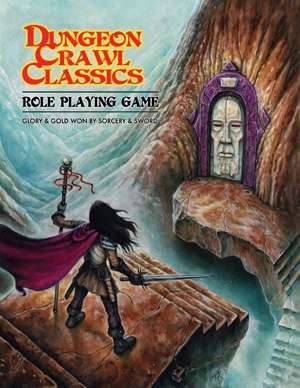Tonight, we played through a Dungeon Crawl Classics Funnel session. The adventure? Sailors on the Starless Sea.
The experience? Unforgettable.
As in, I’ve now done it once, and I never want to do it again.
Dungeon Crawl Classics is an old-school revival game that takes the silliest things of old-school play – the things that you probably didn’t experience and only heard about – and makes them into an RPG. There’s genius in there, but it ends up as a game that I don’t think is very good. It would certainly not be good for my group.
The funnel is a session where you play a bunch of zeroeth level characters and get to see which ones survive the experience, and you get to play in later games. Each of the characters is created randomly. As in, you roll all the ability scores using 3d6, and you roll them in order. This is how it was done in the earliest days, and it is – by Crom! – the way Dungeon Crawl Classics will do it.
In the very earliest days, people did this. If they rolled poorly, the character would meet an unfortunate fate and they’d roll again next week. That unfortunate fate was often intentional on the part of the player.
So, DCC says, “Let’s not keep you waiting for weeks and weeks until you find a playable character. Let’s roll three or four to start with, and the one that survives you get to keep.”
Which means a gaggle of characters that are basically just wandering ability scores go into a deadly dungeon, and only some come out. The fun – if you find any – comes from the ridiculous ways they die.
They have a weapon that probably does d4 or d6 damage, no armour, no spells, and not much chance of surviving.
In Sailors on the Starless Sea, the primary monsters you fight have AC 12, hp 3, Damage 1d6. Basically, any time they hit one of your characters – about 50% of the time – that character dies.
Trying to work out how combat worked was tricky. Fifteen characters in the funnel vs fife beastmen? We tried a few things, before I looked at the books and determined that it was easiest to just assume that we were in a squad that had five characters (one for each player) in the front rank, and with the other characters bring up the rear. If I lost a character, my second character would take his spot, and so on and so forth.
Doing it this way made the battles faster. It meant that you put the character you wanted to live in the back, and hope that there wasn’t a trap that took out the back characters. (There’s one of that sort in the adventure).
Whenever we got into a mass battle, we’d lose several characters. And it wasn’t long before players had lost all their characters and we had to roll new ones.
The adventure notes that in a group of 15 characters, 7-8 generally survive. We lost 17 characters over the course of the adventure. We ended up with -2. Oh wait, we kept making new ones.
Now, you might be thinking that we were clueless playing the adventure. That we didn’t take advantage of the opportunities given to bypass the dangers.
This is true to some extent. But what we were finding was whenever we tried something or explored somewhere, we got hurt and characters died. I once had a friend tell me of his experiences playing the Paranoia adventure based on the Dune property. Apparently, every time the party reacted because something happened, it punished the party. And so, the best option was to do nothing. This wasn’t quite like that – but it was very similar, and a lot of it felt very arbitrary.
In fact, I think the adventure is very evocative. It’d make a great adventure with horror themes for a standard party. But that’s not its intent. And it’s not how it came across.
I was not the GM for this adventure. Which is a pity – I have a better grasp of how to run these sorts of adventure. And as a player, I wasn’t given cues that would help me navigate it successfully. Though, now having read it, I’m not convinced that those clues are properly explained in the first place.
And it doesn’t get past the underlying problem that, ultimately, the characters are hopeless in combat, and that random chance is far better at determining who survives than any decision of the players.


I’ve run it before and my groups had fun. But I think the DM needs to run these a certain way — by telegraphing threats, and by playing along with clever ideas the party comes up with. Done right, the players feel smart and the game has a thrilling tension. If the DM doesn’t do this then the players just get led into unavoidable deaths. It sounds like that is what happened here.
I definitely agree with you. There are moments in the adventure that would play better with a sympathetic DM.